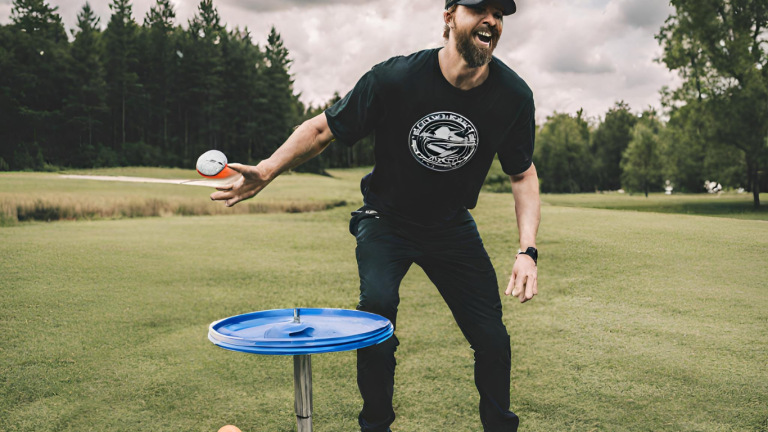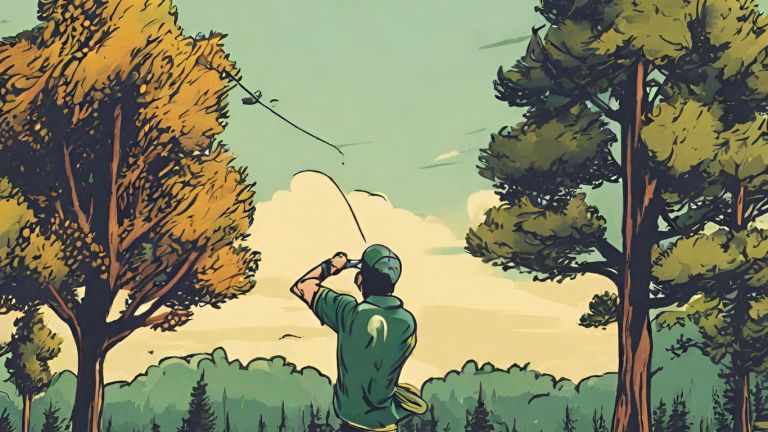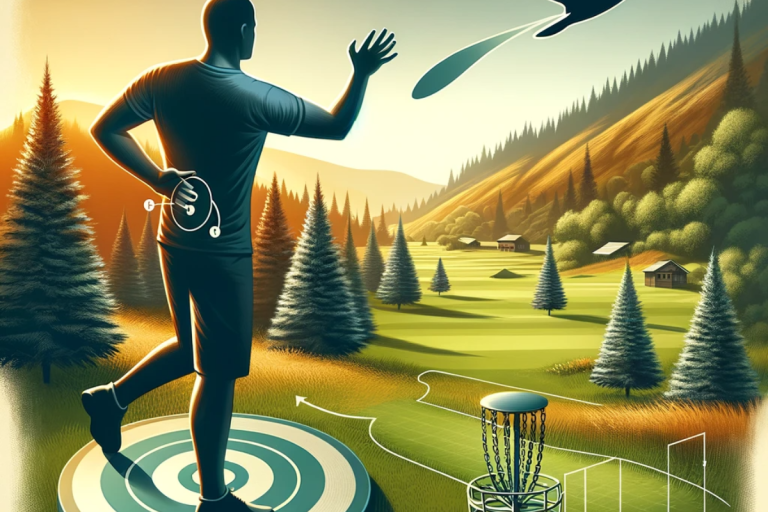How To Throw Frisbee Straight? How to Throw a Frisbee Straight Every Time!
How to throw a frisbee straight? It’s a question I’ve often asked myself during those sun-soaked afternoons in the park. I remember the initial days, watching my frisbee swerve wildly, bringing a mixture of laughter and frustration. It felt like an art, an enigma, something only the pros knew.
But here’s the real important thing With the right technique and a bit of patience, anyone can master it. Over time, and after many wayward throws, I’ve gathered insights and techniques that have transformed my game. In this guide, I’ll share these gems, ensuring you no longer watch your frisbee take unintended detours.
How To Throw Frisbee Straight?
Every time I’d toss a frisbee, it seemed to have a mind of its own. Darn! Why can’t I just throw it straight?The memories of those wobbly throws and wide-eyed onlookers still make me chuckle.
But here’s the important thing that Over countless picnics and gatherings, I learned it wasn’t about brute force, but finesse and technique. The transformation from amateur throws to straight, confident flights was exhilarating. Join me on this journey as I share the steps, tips, and tricks that helped me – and will certainly help you – answer the question, “How to throw a frisbee straight?
Let’s embark on this journey together!
Introduction to Throwing a Frisbee Straight
Growing up, there was this park near my home where I’d often see folks gracefully throwing frisbees. The ease with which their frisbees glided, straight as an arrow, always left me in awe. I tried to emulate them, but my frisbee? It veered left, right, sometimes even backward! That’s when I realized: there’s an art and science to it. Mastering the technique became my obsession.
Personal Experience with the Frisbee
The first time I tried, my throw was all over the place. I’d watch tutorials, mimic the pros, but that perfect throw always seemed just out of reach. One day, a seasoned frisbee player at the park, noticing my struggle, offered a piece of advice. It wasn’t about strength, he said, but about technique and release.
This was my eureka moment. I practiced diligently, focusing on my grip, stance, and wrist movement. Gradually, I started noticing a difference. The once erratic frisbee now began to find a straight path, much to my delight.
The Significance of Technique
Technique is everything when you want to know how to throw a frisbee straight. From the positioning of your fingers to the angle of release, every little detail matters. Small tweaks can significantly impact the frisbee’s flight. Over the years, I’ve learned that while strength can give the frisbee distance, it’s technique that ensures accuracy.
After countless throws and many more lessons, I can confidently say: perfecting the technique makes all the difference.
By maintaining a focus on technique, understanding the nuances of the throw, and leaning into personal experiences, anyone can transform their frisbee game. Just remember: it’s a journey of practice and patience. And trust me, the satisfaction of that perfect, straight throw? Absolutely worth it.
You May Also Like: How to Throw Forehand Disc Golf?
Diving Into the Basics of a Straight Frisbee Throw
Ever pause to wonder why some frisbees soar straight while others just flop around? I did, especially during those early days when my throws seemed more unpredictable than the weather. The secret, as I discovered, lies in understanding the basics.
The Anatomy of a Frisbee
Remember the first time you held a frisbee? Its smooth surface, the slight curve, and that weight balance that felt just right in the hands? Each of these elements is meticulously designed to influence flight. From the central dome to the flat outer edge, every contour has a role. For me, recognizing the purpose behind these designs was step one in refining how to throw a frisbee straight.
The Science Behind the Magic
When I first started, terms like “aerodynamics” sounded like rocket science. But here’s a simpler take: Imagine the frisbee cutting through the air, its design interacting with the surrounding atmosphere. The right technique taps into this interaction. A straight throw isn’t just about power; it’s how the frisbee’s design works with the air. And this, my friend, is where the magic of aerodynamics comes in, without getting too textbook-ish.
Mastering the basics is akin to building a foundation. For those looking to perfect their frisbee game, understanding these principles is a game-changer. As with any skill, knowledge is power. And in the world of frisbee throws, it’s the power to send that disc sailing straight and true.
The Preliminaries to a Straight Frisbee Throw
There’s an adage that says, “Well begun is half done.” This couldn’t be more accurate, especially when it comes to launching that frisbee in a straight line. But before we delve into the actual throw, let’s iron out the essentials.
Picking the Right Frisbee
Stepping into a store, I remember being overwhelmed by the array of frisbees on display. Soft, hard, pro-level, beginner-friendly – the choices seemed endless. But here’s a tip I learned: For those starting, a softer, beginner-friendly frisbee is more forgiving. Once I got a hang of the basics, transitioning to the harder, professional-grade ones was smoother. So, begin with what feels comfortable, and as you progress in understanding how to throw a frisbee straight, you can up the ante.
Grip
Over coffee, a friend once mimed a fan grip and a power grip, highlighting the difference. The fan grip, with fingers fanned out beneath the disc, offers control – perfect for those short, accurate throws. On the other hand, the power grip, with fingers tightly wrapped, is all about, well, power. Understanding when to use which is key. For me, alternating between the two, based on distance and accuracy needs, was a revelation in my journey.
Stance and Positioning
Ever noticed how athletes, before a sprint, position themselves meticulously? That’s because alignment matters. Similarly, with frisbees, your stance sets the trajectory. Facing your target, aligning your shoulders and feet, and ensuring a comfortable distance between them lays the groundwork. When I consciously started paying attention to this, my throws became more predictable and, dare I say, professional.
Remember, the pre-throwing steps, as basic as they might seem, are crucial. Like a chef with the right ingredients, mastering these steps ensures you’re poised for that perfect straight frisbee throw.
Mastering the Motion
After all the prep, the grip, the stance, comes the moment of truth: the throw. But here’s what I’ve learned: Throwing a frisbee isn’t just about brute force. It’s an intricate dance of wrist action, power modulation, and the ever-important follow-through. Let’s break this down.

The Wrist Flick
While watching pros, I noticed a consistent trend: a distinct wrist flick. This wasn’t by accident. The wrist flick determines the spin, and the spin, in turn, stabilizes the frisbee. Think of it like a top. Without a good spin, it wobbles and falls. Similarly, a frisbee without a solid wrist flick veers unpredictably. Once I made this wrist action second nature, my frisbee’s path became more aligned, and learning how to throw it straight felt less daunting.
Power vs Precision
In my early days, I’d often muster all the strength I could and hurl the frisbee. Result? More often than not, it didn’t go as planned. With time, I realized it’s not just about power; it’s about controlled power. Modulating force based on distance and wind conditions became a game-changer. In essence, it’s like golf. Sometimes a gentle tap is all it takes, while other times, you swing with all your might. Striking this balance is pivotal.
Follow-Through
The first time I heard about the importance of follow-through, I was skeptical. But, think of it like bowling. The arm movement post-release dictates the ball’s direction. Similarly, with frisbees, your arm’s motion post-throw can influence its trajectory. Being mindful of a smooth, controlled follow-through ensured that my frisbee didn’t just start right but also ended its journey as intended.
In essence, the art of the frisbee throw is a combination of understanding, practice, and nuance. With each throw, with each flick of the wrist, with every controlled release, you inch closer to that straight, flawless flight.

Common Frisbee-Throwing Errors
Ah, mistakes. They’re the little (sometimes big) hiccups in our learning curve. When I began my frisbee journey, I made plenty. But you know what they say: you learn more from failures than from success. So, let’s dive into some common missteps many of us make when trying to master the art of throwing a frisbee straight and, more importantly, how to sidestep them.
You May Also Like: How To Throw Disc Golf Farther?
Over-Rotating the Wrist
The wrist flick, as I’ve discovered, is paramount. But there’s a fine line between a precise flick and an over-rotation. I recall a sunny day at the park when my over-zealous wrist movement sent the frisbee veering wildly off course. It’s like turning a doorknob; a gentle twist opens the door, but overdo it, and you might just break the knob. The trick? Practice consistent, controlled wrist movements. By consciously reducing excessive wrist action, I noticed my throws becoming more straight and predictable.
Arm Only?
For the longest time, I believed the arm did all the work. Boy, was I wrong. It’s not just an arm sport; it’s a full-body experience. Once a friend pointed out my static torso, I decided to incorporate it into my throws. Think of it as a baseball pitch. The power comes from the core, channeled through the arm. By engaging my torso, not only did I gain more force, but I also achieved better directional control.
Timing the Release
Too early or too late, both can spell disaster for that perfect straight throw. I’ve had moments where releasing too early sent my frisbee skyrocketing upwards. Conversely, a late release had it skimming the ground. The solution? Mindful practice. By continuously paying attention to my release timing, adjusting based on the throw’s outcome, I honed in on that sweet spot.
In the grand scheme of frisbee throwing, errors are par for the course. But with awareness, practice, and perhaps a few friendly tips from seasoned players, those errors diminish. Remember, the path to learning how to throw a frisbee straight is paved with patience and persistence.

Unlocking the Potential: Advanced Frisbee Techniques
After months of dedicated practice, I began to feel quite confident in my frisbee throws. However, the more I played, the more I realized that there’s always room for improvement. Beyond the fundamentals, there are subtle nuances that can truly take your frisbee game to the next level. From adapting to unpredictable weather conditions to refining your practice regimen, these advanced tips have the potential to make a significant impact on your performance.
Harnessing the Wind to Your Advantage
Have you ever released a frisbee on a breezy day, only to watch it take an unexpected path? I’ve certainly been there. The wind can be a game-changer, but instead of seeing it as an adversary, I’ve learned to work in harmony with it. By carefully assessing the wind’s direction and intensity, I adjust my throwing angle and power accordingly. For example, when faced with a strong headwind, I apply greater force and employ a slightly upward trajectory. It’s important to remember that the wind isn’t your enemy; it’s simply another factor to master in the pursuit of competitive frisbee excellence.
Practice, but Make It Productive
It’s not just about practicing; it’s about practicing right. I’ve spent countless hours throwing aimlessly, wondering why I wasn’t improving. Then, a seasoned player introduced me to targeted drills. One of my favorites? Setting up markers at varying distances and angles and aiming to hit each one. Another is practicing with a partner, focusing on both distance and accuracy. By adding structure and goals to my practice sessions, the improvement was remarkable.
Monitor, Reflect, Adjust
One of the best pieces of advice I received was to keep a progress log. At the end of each week, I’d jot down what went well and areas of struggle. Did I consistently veer to the left? Was my wrist flick too weak? By regularly assessing my performance, I could make specific adjustments. Over time, this self-awareness transformed my throws from good to great.
Tapping into these advanced strategies has transformed my frisbee game. And trust me, with dedication and the right approach, mastering how to throw a frisbee straight, even under challenging conditions, becomes second nature.
The Frisbee Chronicles
Embarking on the journey to master the art of throwing a frisbee straight has been filled with highs, lows, and many a humorous mishap. It’s not just about perfecting the throw, but also about the stories that come along with the process. From my own blunders to expert insights, there’s a lot to unpack.
My Frisbee Faux Pas
Oh, the memories! During one of my initial attempts, I remember aiming for a straight throw, only for the frisbee to comically boomerang back towards me. While it left my friends in splits, it taught me the importance of wrist control. Another time, aiming for a distant tree, I accidentally sent it crashing into a picnic, much to the chagrin of a sunbathing couple. Each mishap, as embarrassing as it was, brought with it a lesson. And trust me, these personal tales of trial and error play a pivotal role in the learning curve.
Expert Insights
In my quest for frisbee excellence, I’ve had the privilege of interacting with seasoned players. One piece of advice that stood out was from a frisbee champion, who said, “Consistency is key. It’s not about how hard you throw, but how regularly you practice.” His words resonated deeply. The emphasis wasn’t on power but on repetitive, consistent practice. Another expert emphasized the importance of mental focus, saying, “Your mind guides the frisbee. Visualize the trajectory before releasing it.” These pearls of wisdom, grounded in years of experience, became the cornerstone of my practice sessions.
While my journey with frisbee has been filled with its share of laughter and lessons, it’s the amalgamation of personal experiences and expert guidance that truly shaped my throws. Whether you’re a beginner or a seasoned player, remember that every throw tells a story. So, as you aim to master how to throw a frisbee straight, cherish each moment, mishap, and milestone.
Conclusion
So, we’ve journeyed together through the ins and outs of that elusive straight frisbee throw. From the basics to the advanced, from the blunders to the successes, it’s a path that requires dedication. But remember, every throw, every spin, and every catch is a step forward.
Patience and Practice
I can’t emphasize this enough – patience is your best friend. When I first began, trust me, it wasn’t a walk in the park. There were days when my throws looked more like wonky boomerangs than the sleek, straight shots I aimed for. But with every practice session, every dusk spent on the field, the progress was evident. The joy of watching that frisbee sail smoothly, straight as an arrow, is unparalleled. It’s a mix of pride, satisfaction, and pure adrenaline. So, keep at it, and soon enough, you’ll find your rhythm.
Join the Frisbee Family
But don’t just take my word for it. I urge you to share your journey, the highs, the lows, and everything in between. There’s a vibrant community of frisbee enthusiasts out there, eager to swap stories, tips, and words of encouragement. Engage, learn, and grow. After all, mastering how to throw a frisbee straight is not just about the technique; it’s about the shared experiences, the camaraderie, and the collective joy of the game.
In wrapping up, here’s my final nugget – stay persistent, relish the journey, and never stop throwing. And as you hone that perfect straight throw, remember to share, connect, and inspire.
FAQs
Q1:How can I ensure my frisbee throw goes straight every time?
Answer:
Consistent practice, correct grip, and proper wrist flick are key for a straight throw.
Q2: What’s the most common mistake when trying to throw a frisbee straight?
Answer:
Over-rotating the wrist often leads to a curved or wobbly throw.
Q3: Are there specific frisbees designed for straight throws?
Answer:
While frisbee design can influence flight, technique is crucial for straight throws.







